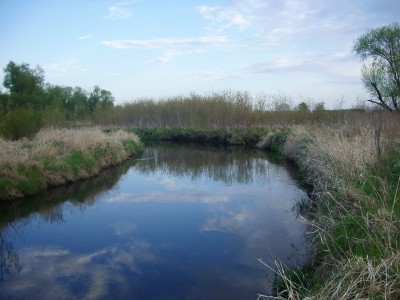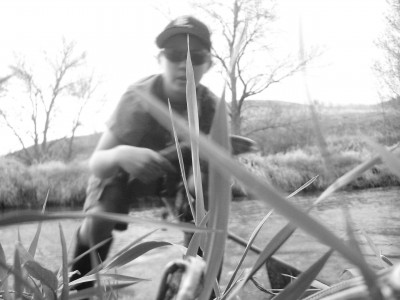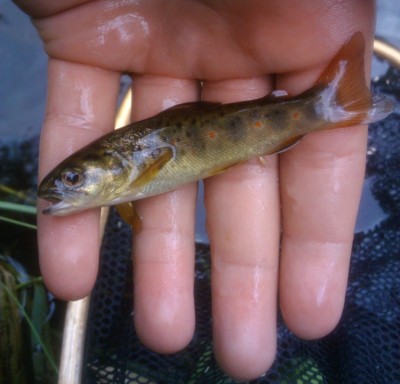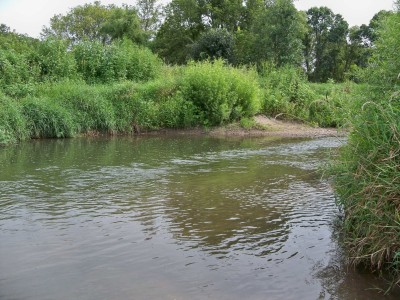
One spring evening before the weeds were too high or the mosquitos too thick Grandpa, Braden, and I set out to fish a creek that had rumors of holding big brown trout. It was one of those creeks where the fishing was good, but the catching was a bit of a different story. We had fished it in the past a few times, but never very hard, and hadn’t caught much. Actually, we never really caught anything. It was a kind of pseudo spring creek, gushing from some seeps way up in the headwaters, but lacking the typical spring creek character of dense watercress, sputtering rifles, and emerald-blue water. It ran a little on the warm side for trout streams – sometimes warmer than it really should in the summer months. There weren’t many trout prowling its waters, but it was somewhat close and provided a quick evening of scenic (and often amusing) fishing, so we fished it anyway. We never really expected much, so a fishless day wasn’t a huge disappointment.
Grandpa and I fished downstream while Braden headed off upstream into the woods. We nymphed pools and bounced beadheads through the riffles. We dragged flies through logjams and floated dries along the seams. We tried hard to entice a trout, but nothing happened.
As sunset approached, we packed up our rods and started toward the car. Braden appeared out of the bushes, and we exchanged stories. He had fished some nice runs with a nymph and was able to pull out a lone trout, a beauty of a sixteen inch brown. I was quite excited, not so much about the nature of his catch but the fact that he actually caught a fish, a trout, and a nice one at that out of a marginal creek.

Marginal creeks can provide some good fishing at times, even producing some large trout. I often struggle with deciding between making the long drive to fish more productive streams or spend more time fishing a marginal creek. A stream’s trout density doesn’t necessarily determine the quality of a fishing trip – you can catch just as many fish on a lower density creek as you can on a highly pressured stream full of trout if you know where to look. I love fishing famous blue-ribbon waters just as much as the next guy, but shorter drives equal more fishing time, which I’ll take gladly whenever I can get it. Here are eight tips to make your trips to less celebrated creeks more productive, in no real specific order. If you have a tip to add or find something I missed, drop us a comment below – I’d love to hear your feedback.
1. Keep moving
Covering a lot of ground is vital on these types of creeks. While you can sit and fish one good hole for hours on a fertile spring creek or tailwater, don’t expect to get much action doing this on a marginal creek. If the fish don’t hit after a few good drifts, move on. Good structure tends to be spread out, and getting your fly in front of as many trout (and holding spots) as possible will increase your chances of finding a hungry one. Hiking and sight fishing “New Zealand-style” can be very effective, and often makes for some very exciting fishing. However, if you do find fish you might want to hang around a while. Leaving fish (especially feeding trout) to find fish is never a good idea, unless they are spooked.
2. Find cold water
Warm water is the kiss of death in marginal creeks, and is often the major factor in determining a stream’s trout-holding capabilities. Water temps dictate when and where the fish will be holding, so if you can find cold water, you can usually find fish – and sometimes lots of them. A small pool thermometer or stream thermometer works quite nicely for finding good water, and should always be in a fly fishers pack. The “optimum feeding range” for trout is 50 to 68 degrees F(1), with the maximum survival temp around 75 degrees F. While trout may be around in 72 degree water, they probably won’t be very responsive to your offerings. Springs, seeps, and tributary creeks are good spots to check. Headwaters are often a good choice because they are closer to the source of spring creeks and therefore run colder and more trout-friendly. On the flip side, warmer water often contributes to a larger baitfish and crustacean population, which is responsible for the larger trout marginal creeks often produce.
3. Fish early and late in the season
This one goes along with #2. Water temps are usually much more favorable for fishing in the spring and fall. Not only will you find more hatching bugs, but the trout will naturally be feeding more aggressively, especially in the fall. Hitting these creeks in the middle of a hot summer day is generally not a good idea. If you do decide to head out on muggy August afternoon, fish shaded areas, deep dark pockets, and fast water where it will be colder and hold more oxygen. Terrestrials and tiny nymphs are great summer flies. While you can still catch trout through the heat of the summer, spring and fall will bring much more favorable conditions to target these fish.
4. Browns and rainbows
Since brown and rainbow trout can tolerate slightly warmer water than brookies, I usually focus on streams that hold these species when scouting new creeks. With that said, there are a few hidden brook trout creeks that might be labeled as marginal but still provide good fishing at times.
5. Check the records
Getting on the web and searching for stream records can prove to be an invaluable piece of your scouting game. DNR records with stocking, electrofishing, and access points can minimize wasted fishing time by pinpointing likely spots. Forgotten creeks with past stockings of species like brown trout that can tolerate and spawn in lower water quality are prime targets.
6. Fish attractor patterns
Marginal creeks seldom have the prolific insect life associated with spring creeks and tailwaters, so trout are far less likely to become selective. My favorite combo for prospecting unknown waters is a small orange stimulator dry and a pink squirrel nymph or a Hare and Copper. Any generic nymph such as a pheasant tail or copper john around a #14 or #16 will work fine. Midges are a favorite for a dropper, as they are present in almost every body of water and usually eaten by trout. Streamers are also a great choice for covering a lot of ground quickly, and just might land you a lunker.

7. Experiment!
Fish different types of structures and fly styles. Don’t be afraid to try unconventional techniques and spots, as trout will sometimes develop unique holding patterns. If riffles and pools aren’t producing, try slow water with logjams or overhanging brush. This saved the trip for me one hot summer day. I was fishing with Grandpa and Noah on a small creek that reportedly held a small population of brook trout. Temps near ninety and a bright, clear sky effectively cleared the holes of all trout. Many drifts through traditional good-looking riffles, runs, and pools with the trusty pink squirrel had me nearly convinced the waters were void of trout. I was finally able to “jig” a shimmering, vividly-colored brook trout out from under a thick log jam in some slack water.

8. Set your expectations
One of the mistakes most often made in fishing marginal trout waters is not setting realistic expectations. If you’re looking to slay numbers of fish, go elsewhere, but if you can stand going fish-less sometimes and are willing to do a little exploring, you might just find a hidden gem – and often have it all to yourself. Marginal creeks often hold some larger trout due to the warmer water and higher baitfish biomass, so it will often turn into a trophy hunt. In my book, solitude and a large trout or two more than makes up for the numbers of small fish you might catch fishing more productive waters. Sometimes it can get tough, though. You might go a few long, fish-less days without even seeing a trout before hitting it right and finding the honey hole, but don’t get discouraged. Discovering new and overlooked waters is one of the joys of trout fishing, and sometimes there is more to a good day of fishing than just catching fish.
—————-
We have fished the brown trout creek and many other marginal creeks like it since then. Some days have been good, with trout in the net, and others have been completely fishless. Regardless of if you’re catching fish or not, marginal creeks offer a constant challenge and force you to adapt to the situations presented, often sharpening your skills as a fly fisher.
Notes: (1) from http://www.flyanglersonline.com/features/canada/can10.php
Tight Lines,
Conner
